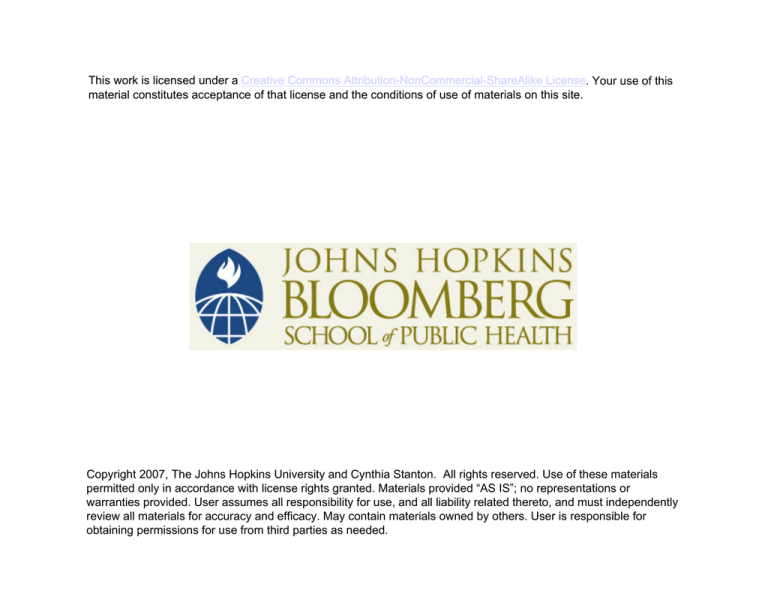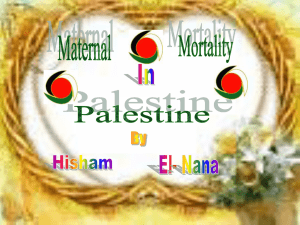
This work is licensed under a Creative Commons Attribution-NonCommercial-ShareAlike License. Your use of this
material constitutes acceptance of that license and the conditions of use of materials on this site.
Copyright 2007, The Johns Hopkins University and Cynthia Stanton. All rights reserved. Use of these materials
permitted only in accordance with license rights granted. Materials provided “AS IS”; no representations or
warranties provided. User assumes all responsibility for use, and all liability related thereto, and must independently
review all materials for accuracy and efficacy. May contain materials owned by others. User is responsible for
obtaining permissions for use from third parties as needed.
Maternal Mortality and Morbidity
in the Developing World
Cynthia Stanton
Department of Population/
Family Health Sciences
Objectives:
• Describe
– the magnitude,
– distribution and
– causes of maternal mortality worldwide;
• Discuss measurement issues re:
– maternal mortality and
– maternal/obstetric morbidity
Defining Maternal Death
According to the Tenth Revision of the ICD:
Maternal Death:
A maternal death is the death of a woman while pregnant or
within 42 days of termination of pregnancy, irrespective of the
duration and the site of the pregnancy, from any cause related
to or aggravated by the pregnancy or its management but not
from accidental causes (WHO 1993).
NOTE: 2 criteria
•Temporal relationship to the pregnant state
•Causal relationship to the pregnant state
Pregnancy-related death: “time of death” definition;
Irrespective of cause.
Maternal Mortality Estimates by MDG
Region (2000 estimates)
Region
Maternal Mortality Ratioa
Number of Maternal Deaths
World Total
400
529,000
Developed Regions
20
2,500
Europe
24
1,700
Developing Regions
440
527,000
Africa
830
251,000
Northern Africa
130
4,600
Sub-Saharan Africa
920
247,000
Asia
330
253,000
Eastern Asia
55
11,000
South Central Asia
520
207,000
South Eastern Asia
210
25,000
Western Asia
190
9,800
Latin American & the Caribbean
190
22,000
Oceania
240
530
aMaternal
mortality ratio: maternal deaths per 100,000 live births
What do we know about trends in
developing countries in maternal
mortality?
• Given limitations of practical methods of
measurement, very little
– Model-based methods not really appropriate for
trend analysis
• It is suspected, that little has changed globally
– There are success stories (example: Sri Lanka,
Thailand, Malaysia, Honduras, Egypt)
– Shows that substantial declines (~50%) can be
achieved in less than 25 years
Medical Causes of Maternal
Mortality
• Direct causes: 4 causes of death directly
related to the pregnant state; hemorrhage,
eclampsia, sepsis and obstructed labor,
(abortion)
• Indirect causes: pre-existing conditions which
are exacerbated by the pregnant state
(malaria, heart disease, anemia, HIV, etc)
1) Hemorrhage: bleeding of more
than 500 cc
Antepartum
before 20 weeks:
• Ectopic Pregnancy
• Abortion
after 20 weeks (not
abortion related)
• Placenta Previa
• Placental Abruption
Postpartum
Massive vaginal
bleeding after delivery
due to
• Uterine atony
• Retained placenta
• Genital tract
lacerations
• Inverted uterus
Large loss of blood leads to shock and death
Ectopic Pregnancy
• Pregnancy which is outside the uterine cavity
• Can be in the tube, ovary, abdomen or other
locations
• Treated surgically by removal of the pregnancy or
tube
• Also treated medically, although not available in
developing countries
• If ruptures can lead to hemorrhage and death
Antepartum Hemorrhage
• Placenta Previa
– placenta is in front of the cervix
– typically requires cesarean delivery to
avoid maternal and fetal death
Antepartum Hemorrhage
• Placental Abruption
– placenta separates prematurely from the wall of
the uterus
– if happens during labor can be successful
delivery, prior to labor can lead to death
2) Pre-eclampsia and Eclampsia
• Disorder of late pregnancy (or post partum) characterized
by:
– elevated blood pressure
– protein in urine
• Other symptoms:
– headache, blurred vision, abdominal pain/tenderness,
difficulty breathing
• Complications include:
– liver rupture, stroke, seizure or death
3) Infection
• Also known as puerperal infection or sepsis
• Defined as temperature of 38° C or more
– during pregnancy,
– during labour or
– after childbirth
• Diagnosis is made by evaluating the patient
for accompanying signs or symptoms
4) Obstructed Labor
Result of:
• Malpresentation:
– breech
– transverse
– Shoulder
• Cephalopelvic disproportion – inability of head
to fit through pelvic canal
Percent Distribution of Causes of Maternal Death
100%
90%
Hemorrhage
Hemorrhage
Hemorrhage
80%
Sepsis
Sepsis
70%
60%
50%
40%
30%
Hemorrhage
Sepsis
Sepsis
Abortion
Abortion
HDP
Obstructed labor
Abortion
Abortion
HDP
HDP
Ectopic Preg
HDP
Other direct
Obstructed labor
HIV/AIDS
Obstructed labor
HIV/AIDS
Anemia
Anemia
HIV/AIDS
Anemia
Obstructed labor
10%
Other indirect
HIV/AIDS
Anemia
Other indirect
Unclassified
Unclassified
Unclassified
Africa
Asia
0%
Source: Khan et al. 2006, The Lancet, Vol 367
Other indirect
Unclassified
20%
Other indirect
Embolism
LAC
% of births w/ medically trained attendant
N of
countries
MDG regions
1990
2000
% increase in
use of a
skilled
attendant
1990-2000
40.6
67.0
65.0
39.4
39.8
1.0
76.9
81.8
6.4
% of births with a skilled
attendant at birth
Northern Africa
3
Sub-Saharan
Africa
31
Latin
America/Caribbean
22
East Asia
1
53.4
72.1
35.0
South Asia
7
32.3
41.4
28.2
South-eastern Asia
3
42.1
64.4
53.0
Western Asia
4
77.1
88.6
14.9
Eurasia
2
99.5
96.6
-2.9
Developing
countries
73
44.7
54.2
21.3
Measurement of
Maternal Mortality
Sources of data on maternal mortality
• Civil Registration
• Hospital-based Studies
• Reproductive Age Mortality Studies (RAMOS)
• Large Population-based Surveys
• National Population Censuses
• Statistical Models (Unicef/WHO estimates)
• New Variant Sisterhood method: a work in
progress
Maternal Mortality Estimates based on
Empirical Data
Reproductive-Age Mortality Studies (RAMOS):
•Considered the gold standard
•Defining characteristic: rely on multiple sources of data to
identify adult female deaths/maternal deaths:
explore civil registration, medical records, undertaker,
TBA,mother’s groups, market, newspaper,verbal
autopsy
•Once adult female deaths have been identified, a team of
physicians reviews each case, determines cause of death
RAMOS - continued
Advantages:
•More complete reporting of maternal deaths
•Obtain very useful information on care-seeking behavior,
avoidable causes of death (facility-based and
social)
Disadvantages:
•Expensive and labor-intensive
• Rarely carried out at a national level
(exceptions: Egypt, Honduras, Guatemala)
• Little attention paid to verification of the denominator
• Great variation in what gets called a “RAMOS”
Summary of Avoidable Factors for Maternal Deaths;
Egypt NMMS; 2000
100
80
70
93% of all maternal deaths had contact with
Health facilities in the events leading to death
60
50
43
40
30
30
19
4
10
8
6
4
Lack of
anethesia/ist
11
Lack of
drug/supplies
16
Substandard
care by Daya
20
19
Avoidable Factors
81% due to avoidable factors
No avoidable
causes
Lack of blood
Substandard
care by
Obstetrician
Substandard
care by
Midwife
Substandard
care by GP
Poor quality
ANC
0
Delay seeking
care
% of all maternal deaths
90
Maternal Mortality Estimates based on
Empirical Data
Large Population Surveys: 3 Methods of Data
Collection for MMR Estimation:
1) The Original Sisterhood Method (indirect estimation)
2) Sibling-based method for direct estimation
(DHS adaptation of the original sisterhood method)
3) Identification of all female deaths in the household same as census
Sibling-based method for direct estimation
(DHS adaptation)
Consists of an additional module added to women’s
individual questionnaire/household schedule
More demanding data requirements than the indirect
method:
Additional questions which:
• identify all siblings in order, and determines
9their sex,
9vital status,
9age if living,
9age at death if dead AND
9for adult female deaths: if death occurred during pregnancy
childbirth or 2 mo following the end of pregnancy or childbirth
Sibling-based method - continued
•Statistic calculated is the M M Rate, converted
to M M Ratio by dividing by the General
Fertility Rate
•Reference period: because it is from direct
estimation –
it is up to analyst
0-6 years or 0-9 years prior to survey:
•
very dependent on sample size
•
trend data generally not possible
DHS M M Ratios
0-6 yrs before survey
C. A. R.
1451
Madagascar
663
Malawi
752
Morocco
380
Namibia
395
Niger
672
Senegal
569
Zimbabwe
393
Indonesia
454
Philippines
208
Bolivia 1
580
Bolivia 2
396
Peru
218
95% CI
(1194-1709)
(523-803)
(497-1006)
(255-506)
(259-582)
(511-833)
(359-779)
(269-517)
(378-529)
(141-275)
(380-800)
(237-555)
(148-288)
Source: Stanton et al. 2000 Studies in Family Planning
DHS M M Ratios
0-6 yrs
before survey
C.A.R
Madagascar
Malawi
Morocco
Namibia
Niger
Senegal
Zimbabwe
Indonesia
Philippines
Bolivia 1
Bolivia 2
Peru
1451
663
752
380
395
672
569
393
454
208
580
396
218
Significant
Percent
7-13 yrs
before survey change change
775
87 p<0.05
543
22
408
84 p<0.05
438
-13
154
156 p<0.05
779
-14
406
40
159
147 p<0.05
292
55 p<0.05
212
-2
385
51
315
26
296
-26
Sibling-based method - continued
Strengths:
•Provides all 4 indicators of maternal mortality
•Is relatively inexpensive if DHS is planned
Weaknesses:
•Larger sample sizes required, generates large sampling errors
•Results are interpreted assuming similar precision as other
DHS estimates
•Only produces a national level estimate
•Requires complex data processing
•May replace other modules of interest
•Evidence of under-reporting of adult deaths in recent period –
unclear how to adjust
Measuring maternal mortality
in the
National Population Census
How is pregnancy-related mortality
measured via a census?
• All live births in the household in the last 12-24 months
are recorded
• All household deaths (plus sex and age at death) for the
last 12-24 months are recorded
• Only for adult female deaths:
– Did the deceased die:
• during pregnancy?
• during childbirth?
• within 42 days (6 weeks) of the termination of pregnancy?
• REMEMBER: only ask these questions of ~ 1% of
households;
• The issue is space on the page;
Optional/Supplemental question:
• Where did she die (in hospital, at home, en
route to hospital; other outside home)?
• Follow up questions using a verbal
autopsy/medical record review to discern
maternal from pregnancy-related death
could be added for all or a sub-sample of
adult female deaths (a very interesting, but
major additional undertaking)
Results from 5 country experiences
Country
Benin
(1992)
Islamic
Rep of
Iran
(1996)
Lao
People’s
Dem Rep
(1995)
Madagas- Zimbabwe
car
(1992)
(1993)
Adjustment
Factor:
births
1.34
1.30
1.65
1.0
1.0
Adjustment
Factor:
deaths
2.7
3.0
1.6
2.5
1.0
NOTE: Adjustment for deaths almost always > than for births. Must be prepared
for this magnitude of adjustment. Can be hard to accept.
Source: Stanton et al. 2001. Bulletin of the WHO 79(7)
Results from 5 country experiences
Country
Unadjusted
MMR
Adjusted
MMR
(high, low
variants)
MMRs from
external
sources
Benin
Islamic
Rep of
Iran
Lao
People’s
Dem Rep
Madagas- Zimbabwe
car
168
39
821
NA
395
338
(250-375)
88
(58-95)
796
(746-871)
NA
(NA)
395
(NONE)
498
(DHS)
NA
NA
NA
393
(DHS)
NOTE: Some adjustments are very large. The benefit of no sampling error should
be judged against unmeasurable non-sampling error, plus the valdity of assumptions
underlying the high/low variants. IN SUMMARY: there are many advantages,
but this is far from perfect.
Source: Stanton et al. 2001. Bulletin of the WHO 79(7)
Most recent censuses w/ MM
measurement
Country
Female Deaths Prop.
Maternal
Obs.
Adj.
Births ‘000
Obs.
Estimated
MMRatio
Adj.
Honduras
2,195
3,899
0.105
170.4
200.5
204
Nicaragua
1,867
1,716
0.088
123.2
123.1
123
Paraguay
3,120
2,337
0.107
116.8
126.5
200
In summary:
• Using the census to measure pregnancy-related
mortality offers many advantages to traditional
approaches
• BUT, it is not a magic bullet. It comes with its
own limitations and results should be interpreted
accordingly
• The Measure/Evaluation project has produced
step by step Guidelines in
English/French/Spanish on the
evaluation/adjustment of such data. See:
www. cpc.unc.edu/measure/publications/index
In summary: continued
• The draft UN Principles and
Recommendations for National Population
Censuses now recommends:
– Measurement of adult, maternal and injuryrelated mortality
– Soon to be ratified
• Funding is being assembled to assist ~30
countries with preparation and data
evaluation
Overall conclusions regarding
maternal mortality measurement:
• All practical M M R data collection techniques
generate approximate levels of M M;
• Different data collection techniques embody different
strengths and weaknesses and reference periods
which should not be overlooked;
• It is difficult, and therefore, unwise, to compare M M
indicators collected via different methodologies;
– But everybody does it;
• M M R is very effective advocacy tool – It is an MDG
with targets. It is prone to serious misinterpretation;
Defining and Measuring
Maternal Morbidity
•
Terms and definitions; Acute or long-term sequelae?
1. Women experiencing major obstetric complications
–
non-specific list of direct complications used in the UN process
indicators
2. Women experiencing life-threatening complications
•
Term is often used and often not defined
3. Women experiencing absolute maternal indications
–
Very specific list of conditions for which the woman will not survive
without surgical interventions
4. Women experiencing near-miss events
–
Several different approaches to definition (criteria-based; organ
failure; management-based (admission to ICU); all focus on
extreme end of continuum between life/death
Obstetric morbidity, what do we
expect?
• Is there a “natural” level for obstetric
complications? Or, does it vary by
population?
• What should one monitor:
– Incidence?
– Severity?
What do we currently “know”
about obstetric complications in
the population?
WHO estimates
that 15% of
births/pregnancies
experience “major
obstetric
complications.
Source: Koblinsky, Timyan
Based on scant
epidemiological data,
some of which is from
developed countries.
MOMA Study in West
Africa:
prospective follow up
of
~4,000 women from 7
mo.
gestation to
postpartum period
Result: 7.5%
experienced major
obstetric complications
Source: de Bernis et
al, BJOG, 2000
Unmet Obstetric
Need Network
Shows ~1 – 1.6%
of pregnancies
associated with
Absolute
Maternal indications
In 6 country study
Current reference
Rate: 1.4%
Example: Survey-based questions
re: symptoms
Hemorrhage:
•Did you lose a lot of blood during labor or delivery, or within
1-2 days after? By this I mean dark red, fresh red, clotted
blood?
• Did you bleed so much you thought you might die?
Eclampsia:
• Did you have a fit (trembling, not caused by fever) during
pregnancy or around delivery?
• During this pregnancy, did you have a problem with severe
swelling in your face and hands?
Population-based measurement:
Validating Women’s Self-Reports of Symptoms
of Major Obstetric Complications:
•
•
•
•
6 studies conducted in Bolivia, Ecuador, Ghana,
Philippines, Indonesia, Benin
All 6 studies were hospital-based, relied on medical
records as the gold standard;
Assessment of Validity: calculated sensitivity
and specificity to determine how closely answers
to individual questions re: symptoms (a
combination of questions) matched medical records
(gold standard)
Questionnaire development: some did
qualitative studies to assist in formulating the
questions used to describe the various
complications
Conclusions of the Task Force:
• Estimating prevalence from self-reported data is not
possible in large-scale surveys. Sensitivity and especially
specificity is too low;
– But everyone does it anyway. STILL – ALMOST 10 YRS
LATER
• It is possible and valuable to ask about women’s perceived
problems in order to ask about health care seeking
behavior in the context of a perceived problem.
• Indicator*: Women who sought care/ Women with a
perceived problem
• * Must construct questionnaire so that you know order of
events
Reported symptoms of birth-related complications
in 13 DHS surveys
53.9
Guatemala
14.5
Dom Rep
42.1
Colombia
16.7
Brazil
43
Bolivia
18.3
Pakistan
23.7
Indonesia
11.9
India
23.3
Egypt
51.6
Zimbabwe
46.2
Uganda
8.7
Namibia
58.6
CAR
0
10
20
30
40
50
60
Percent of Births with Reported symptom of at least one complication
70
Thus, interest in combining facility
with population-based data
• Near-miss (regardless of definition),
which is measured at facility-level, can
be considered population-based by
default
– If a woman had such a serious complication in the
community and did not receive medical care, she
would have died
Conclusions re: measurement of
maternal/obstetric morbidity
• Near-miss:
– reality check re: functioning of hospitals;
– good choice for audits;
– very complicated to collect/define;
• Self-report – what to do? Surveys will not
die
• Story to be continued…









